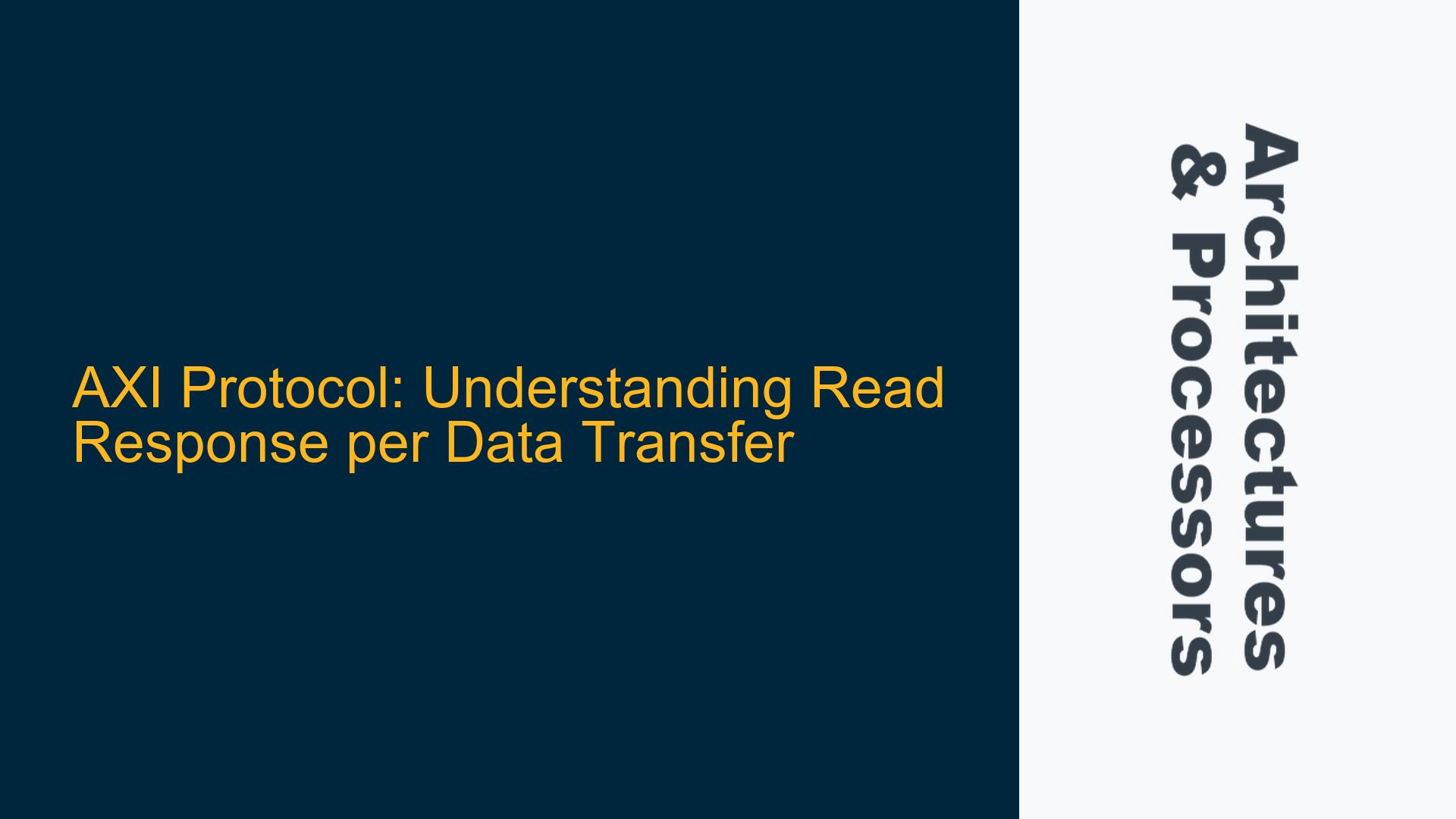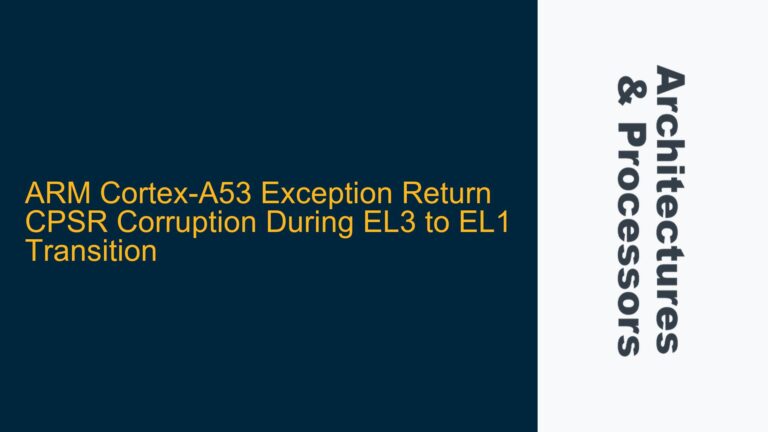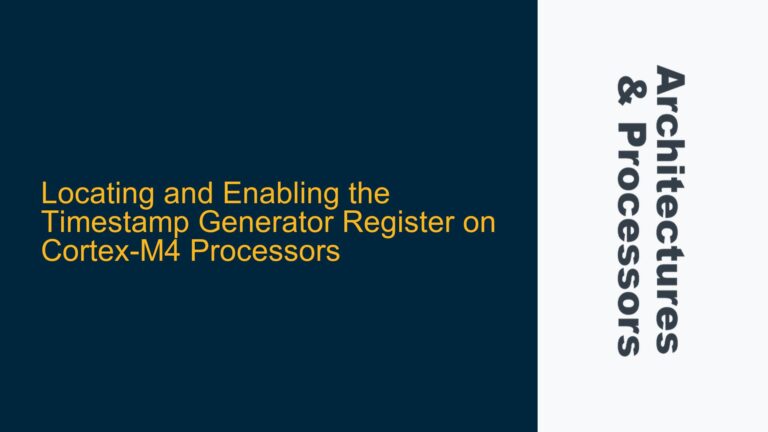AXI Read Response Mechanism and Its Necessity in Data Transfers
The AXI (Advanced eXtensible Interface) protocol is a widely adopted on-chip communication standard for high-performance SoC designs. One of its key features is the separation of channels for address, data, and control signals, enabling efficient pipelining and concurrent operations. A critical aspect of the AXI protocol is the handling of read and write responses, which ensures data integrity and transaction completion. In the case of read transactions, the protocol mandates that a read response (RRESP) is provided for each data transfer (beat) within a burst transaction. This behavior contrasts with write transactions, where a single write response (BRESP) is provided at the end of the entire transaction.
The rationale behind this design choice lies in the unidirectional nature of AXI channels and the need for efficient error handling. The AXI protocol defines five independent channels: Read Address (AR), Read Data (R), Write Address (AW), Write Data (W), and Write Response (B). Each channel operates in a single direction, with handshake signals (VALID and READY) ensuring proper synchronization between the master and slave. For read transactions, the Read Data (R) channel is inherently designed to carry both the data and the response for each transfer. This is because the R channel already flows from the slave to the master, making it straightforward to include the RRESP signal alongside the data.
In contrast, the Write Data (W) channel flows from the master to the slave, and there is no inherent mechanism to send a response back for each individual data transfer. Instead, the protocol introduces a separate Write Response (B) channel, which carries a single response for the entire write transaction. This design minimizes overhead and simplifies the implementation, as it avoids the need for additional signaling for each write data transfer.
The inclusion of a read response for each data transfer in read transactions provides several advantages. First, it allows the slave to indicate the status of each individual data transfer, such as whether it was successful (OKAY), encountered an error (SLVERR or DECERR), or requires retry (EXOKAY). This granularity is particularly useful in systems where data integrity is critical, as it enables the master to take corrective action immediately upon detecting an error. Second, it aligns with the pipelined nature of AXI, where multiple transactions can be in progress simultaneously. By providing a response for each data transfer, the protocol ensures that the master can track the status of each transfer independently, even within a burst transaction.
Potential Misconfigurations and Misunderstandings in AXI Read Response Handling
While the AXI protocol clearly defines the requirement for a read response per data transfer, there are scenarios where misunderstandings or misconfigurations can lead to incorrect implementations. One common misconception is that the read response can be deferred until the end of the transaction, similar to the write response. This misunderstanding often arises from a lack of familiarity with the protocol’s channel architecture and the rationale behind its design.
Another potential issue is the incorrect handling of the RRESP signal by the slave. For example, a slave might always return an OKAY response for all data transfers, regardless of the actual status, and only provide the real response in the final transfer. While this approach might seem simpler, it violates the AXI protocol and can lead to undetected errors or incorrect behavior in the system. The protocol requires that the RRESP signal accurately reflects the status of each data transfer, ensuring that the master can rely on this information for error handling and recovery.
In some cases, the misconfiguration might stem from the use of non-standard or custom AXI slave designs. These designs might introduce deviations from the protocol, such as aggregating responses or altering the timing of response signals. While such customizations might be justified in specific applications, they must be clearly documented and understood by all parties involved in the system design. Failure to do so can result in interoperability issues and complicate the verification process.
Additionally, the interaction between the AXI master and slave can introduce complexities in response handling. For instance, a master might issue a burst read transaction with a specific burst length, but the slave might not be able to fulfill the entire burst due to resource constraints or errors. In such cases, the slave must still provide a response for each data transfer it completes, even if the transaction is terminated prematurely. This requires careful implementation to ensure that the responses are consistent with the actual data transfers and that the master can correctly interpret the transaction’s outcome.
Best Practices for Implementing and Verifying AXI Read Response Handling
To ensure compliance with the AXI protocol and avoid the pitfalls discussed earlier, designers and verification engineers must adopt a systematic approach to implementing and verifying read response handling. The following steps outline best practices for achieving this goal:
1. Protocol Compliance and Channel Architecture Understanding:
- Thoroughly review the AXI protocol specification, paying particular attention to the Read Data (R) channel and the RRESP signal requirements.
- Understand the unidirectional nature of AXI channels and how they influence the design of response mechanisms.
- Ensure that the slave design adheres to the protocol’s requirement for providing a read response for each data transfer.
2. Accurate RRESP Signal Generation:
- Implement logic in the slave to generate the RRESP signal for each data transfer based on the actual status of the transfer.
- Avoid defaulting to OKAY responses for all transfers unless explicitly justified by the application.
- Handle error conditions, such as SLVERR or DECERR, appropriately and ensure that they are reflected in the RRESP signal.
3. Verification Strategy for Read Response Handling:
- Develop a comprehensive verification plan that includes test cases for various read transaction scenarios, such as single transfers, burst transfers, and error conditions.
- Use SystemVerilog and UVM (Universal Verification Methodology) to create reusable testbenches and sequences for AXI read transactions.
- Include corner cases, such as back-to-back transactions, out-of-order responses, and premature transaction termination, to ensure robustness.
4. Debugging and Error Handling:
- Implement logging and tracing mechanisms to capture the sequence of read transactions and their corresponding responses.
- Use simulation tools to analyze waveform traces and verify that the RRESP signals align with the expected behavior.
- Develop error injection tests to validate the system’s ability to handle and recover from read errors.
5. Customization and Interoperability Considerations:
- If customizations to the AXI protocol are necessary, clearly document the deviations and their impact on response handling.
- Ensure that any custom response mechanisms are compatible with standard AXI masters and do not introduce interoperability issues.
- Conduct interoperability testing with different AXI masters and slaves to validate the design’s compliance and robustness.
By following these best practices, designers and verification engineers can ensure that their AXI-based systems handle read responses correctly and efficiently. This not only enhances the reliability and performance of the system but also simplifies the debugging and integration process, ultimately leading to a more robust and maintainable design.
Conclusion
The AXI protocol’s requirement for a read response per data transfer is a fundamental aspect of its design, ensuring data integrity and efficient error handling. By understanding the rationale behind this requirement and adhering to best practices for implementation and verification, designers can avoid common pitfalls and create robust, high-performance SoC designs. The systematic approach outlined in this post provides a roadmap for achieving protocol compliance and optimizing the handling of read responses in AXI-based systems.






